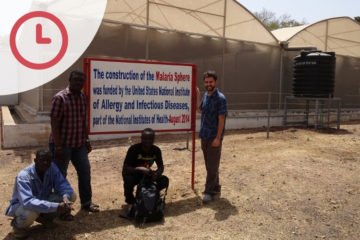Podcast Available on iTunes and Spotify.
Hello, I’m Thomas Locke and this is Five Minutes, the podcast that brings you closer to the people fighting malaria.
Today, I’m joined by Dr Alekos Simoni of Imperial College London. He’s part of the Target Malaria consortium of researchers, using genetic engineering to eliminate malaria.
Dr Alekos Simoni, thanks for joining me.
Thank you.
What is Target Malaria?
Target Malaria is a not for profit research consortium and we want to develop a cost-effective and sustainable genetic technology to modify malaria mosquito populations to reduce malaria transmission.
How does Imperial College London fit into all of this?
What we are developing is a technology that will allow us to reduce the population number of mosquitoes that transmit malaria and Target Malaria is based on three pillars. One is the science which is behind the project to develop novel genetic technology, one is the stakeholder engagement and one is regulation so the Imperial College team is based on the developing the technology itself.
You mentioned this technology. How do genetically modified mosquitoes reduce
transmission?
What we are developing is a technology which is based on gene drive. Our aim is to reduce the population size of mosquitoes that transmit malaria. We are doing that using two tools. One is the making the female mosquitoes sterile or the other tool is by biasing the sex ratio of the population to towards males. In this way, we can reduce the population size of the mosquito. The gene drive, which is at the base of our technology, allows us to spread these genetic modifications to a wide population to reduce the population size.
What’s the difference between gene drives, which is what you’re talking, about and genetic engineering?
A gene drive is based on genetic engineering but is a particular type of modification. It’s a genetic element that can bias its own inheritance in the offspring. Usually, since we have two copies of each gene, every modification has a 50% chance of being inherited in the progeny, because one copy comes from the mother and one copy comes from the father. Gene drive, instead, is a genetic element which is always inherited in the progeny. As a consequence, this type of modification is spread through the population over the generations. It is a type of genetic modification that can spread within the target population and we can use this technology to spread, for instance, something like infertility through a population to reduce the population size of the malaria mosquito.
How long would it take, theoretically speaking, from when you’ve applied the gene drive to when transmission is under control. What sort of timeframe do you have?
We have been working on this technology for many years. It’s a project that started about 15 years ago. In terms of how long it will that take in the field in affecting malaria, that depends on the release rate of the mosquitoes, but essentially we predict that within a few years in the target area where a gene drive is released, we can reduce the population mosquito to levels so low that there are no more cases of malaria transmission.
If you’re based in London doing lots of scientific work, what’s going on in Burkina Faso?
We are collaborators so we are co-developing the technology with our other partners in Africa. We have three partners in Africa at the moment, one is in Burkina Faso, one in Mali and one in Uganda. Our approach is a pathway of development, which is a multi-stage pathway.
This technology is quite controversial with ethical objections raised at the UN. Are those concerns justified?
We are taking the safety about this technology very seriously, at Target Malaria. We are co-developing the technology with our partners and we are also strongly engaging with all the regulatory advisers and bodies to develop a regulatory framework for this technology to be used. At the moment, it has never been used, gene drive technology, anywhere in the world so we are developing this technology and also the regulatory framework to use this technology.
Dr Alekos Simoni, thank you.
Thank you very much.


